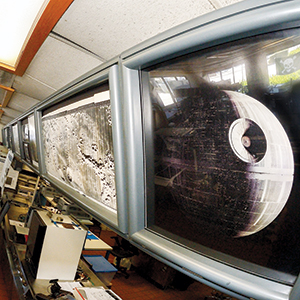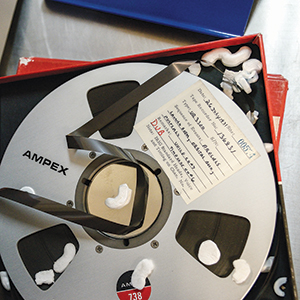Features & Columns
 Inside the 'McMoons' facility, posters are hung in the space once occupied by McDonald's menu items. Photo by Greg Ramar
Inside the 'McMoons' facility, posters are hung in the space once occupied by McDonald's menu items. Photo by Greg Ramar
From August 1966 to
August 1967, five satellites prosaically named "Lunar Orbiter 1-5" were launched from Florida, with the mission of mapping the Moon's surface from close range. NASA carried out the quintet of Lunar Orbiter missions to scout for landing spots, and to check on the levels of solar radiation their astronauts would be facing. After about a month's worth of orbits, the satellites were deliberately crash-landed on the lunar surface so that they wouldn't present a navigation problem to future human travelers.
The satellites consisted of four hexagonal panels, stop-sign shaped, surrounding a central telescopic muzzle. A radar dish stuck out on an arm protruding straight from the side. A 35mm camera snapped pictures from a distance of about 30 to 930 miles up, developed the photos on board, and then synthesized them in radio signals. Meanwhile, continuous signals were sent back to one of three tracking stations in Spain, Australia and the Mojave Desert in California. Each listening station was 120 degrees from the others, to make sure that the craft never broke contact with Earth.
The original data was loaded onto vast spinning magnetic tapes, familiar to anyone who's ever seen a vintage evil-computer movie.
These images ended up as "framelets"—narrow strips about two feet long and one inch wide. When printed out and assembled back in the labs of 1966 and 1967, each framelet was labeled, with handwritten notes marking the mission it came from, which Earth station the signal was beamed to and what small sector of the Moon it illuminated. The prints were then laid together in strips like a bamboo mat.
Casey describes what LOIRP has been doing for years: "After digitizing the tapes, which was no small feat—it involves what I'd assumed was black magic—we had to process the framelets. We'd give them their own file name, color corrections, exposure correction, and edit out any imperfections, without compromising the images."
After the original project ended in 1967, the tapes were classified for years. Then they were declared surplus. There were a thousand or so of these tapes, in reels that weighed about five pounds each. Archivist Nancy Evans, co-founder of the NASA Planetary Data System, and Caltech's Mark Nelson began acquiring old FR-900 tape drives in an early attempt to digitize the analog data. Evans kept the tapes in a barn in Sun Valley, California. In 2007, when Evans decided to clean house, Dennis Wingo and his associate Kevin Cowing brought the tapes and the dusty, busted FR-900 tape drives to NASA Ames.
 NASA stored images captured during the Lunar Orbiter missions on Ampex tape. Photo by Greg Ramar
NASA stored images captured during the Lunar Orbiter missions on Ampex tape. Photo by Greg Ramar
Wingo is the author of Moonrush, a 2004 book about plans to colonize the Moon, both as a way to feed the Earth's hunger for mineral resources, and as a pit stop on the way to exploration of the inner solar system.
"When I was a student at University of Alabama at Huntsville, I only had access to microfilm images of the Moon," Wingo says, speaking via phone from Paris. "I'd heard about the tapes in the 1990s."
The first question, he notes, was getting the 40-year-old Ampex tape drives to work. "Imagine trying to get an Apple IIc functional," he says, "and that machine is only 30 years old." Wingo sought help from Ampex, some 20 miles away in Redwood City. Ampex has no industrial structure on the premises, but retired engineers helped him get the aged machines on line.
"Second," Wingo continues, "NASA wanted to know if we could get workable images from these tapes. I knew from my research that the dynamic range of these tapes was four times what the film record was. [The Jet Propulsion Laboratory at Caltech] wrote to NASA, saying there's no way we could do this project for less than $6 million. But we did it."
Casey Harper was a child when she first saw the McMoon project in 2008. Her mother worked nearby at NASA Ames. "There was me, and my two brothers Chris and Travis," Harper recalls. "My mom didn't want us to be sitting at home all summer long. We became free labor here. Travis worked here about five years, and I came back when I was older."
"I was there at the very beginning; it was over the summer and Dennis needed a building," Casey says. "The advantage of this McDonald's was the ventilators over the grill, which could be used to vent the building when they were doing soldering or drying off the machinery. I wasn't here when they were actually doing the initial processing. I was just cleaning the machine, spraying down the parts. I like old machines, and for me this was like being a beginning engineer—we had brilliant people here who were willing to teach."
In an item praising LOIRP in the Congressional Record, Congresswoman Zoe Lofgren (D-San Jose) paid a compliment to the crowdfunded project's "vision and inspiration."
"We can make a comparison of the surface of the Moon from 50 years ago with LROC," says Colleluori, referencing the Lunar Reconnaissance Orbiter Camera, a current project scanning the Moon. "We look for change—if you can find new micro-meteor impacts on the Moon, you can better characterize what the patterns of the strikes are. If you wanted to send astronauts to Mars, you'd want to have an accurate model of meteor strikes." The idea is to determine, through study of the Moon, how much you'd need to armor a spacecraft against the strikes. Upcoming missions to the Red Planet will have to balance safety against excessive mass.
NUMU's show presents floor-to-ceiling murals of the recovered photos. The semi-forgotten triumph of this space project whets the appetite for further travel. From an aesthetic point of view the pictures show the glowing purity of the lunar surface, with rich blacks of the space around it. Making these supposedly dead tapes speak ensures we're not forgetting more than we're learning.
McMoons: How a Band of Scientists Saved Lunar Image History
Sept. 23 to May 14, 2017
NUMU, Los Gatos


